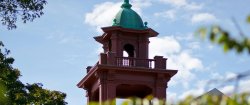Cole Hall Earns LEED Gold Certification
The newly dedicated Susan A. Cole Hall is the University’s second building to achieve LEED Gold status
Posted in: Homepage News, University

Montclair State continues to be a leading campus in sustainability, with the newly renovated, expanded Susan A. Cole Hall achieving Leadership in Energy and Environmental Design (LEED) Gold status through the U.S. Green Building Council (USGBC).
Cole Hall joins the Center for Environmental and Life Sciences (CELS) as one of two buildings on campus to receive the LEED Gold designation. CELS received the designation in 2017.
The USGBC’s LEED green building program is “the preeminent program for the design, construction, maintenance and operations of high-performance green buildings” with projects pursuing LEED certification meeting a set of prerequisites and can earn additional points across several categories that address sustainability issues. Based on the number of points achieved, a project then receives one of four LEED rating levels: Certified, Silver, Gold or Platinum.
Other buildings on campus with LEED status include the School of Communication and Media, certified LEED Silver in 2018; the Feliciano School of Business, certified in 2020; and University Hall, certified in 2008.
“If you look at the USGBC project directory, you’ll see that there are only nine LEED Gold buildings at colleges and universities in New Jersey,” says Shawn Connolly, vice president for University Facilities. “We are very excited to have the distinction of owning two of those now with the addition of Susan A. Cole Hall to our existing inventory of LEED buildings.”
“This project was unique in that it wasn’t a completely new building, like our other LEED buildings,” adds Connolly. “It was a major renovation of our oldest and most iconic building. The building has a rich history and we tried to honor that by recreating many of the historic elements from the original building. Being able to incorporate those elements in a LEED building speaks very well of our design and construction team and sets a great example for historic buildings going forward.”
Connolly promised that the University community can look forward to more sustainable construction and renovations. “I have no doubt that we will continue to pursue green building goals and I look forward to seeing what develops in the future.”
Formerly College Hall, the renovated 113-year-old building was rededicated as Cole Hall on June 22 and reopened to the public last October after a major three-and-a-half year multi-million-dollar renovation. Although the renovations were designed to LEED Silver specifications, the building earned additional points to bring it over the threshold to LEED Gold. Cole Hall was recognized for the following LEED-specific features, including:
- The building is on a site that was previously developed.
- Both bus and rail transportation options are within a half-mile walking distance.
- Exterior landscaping includes native, drought-tolerant plants.
- A 47% reduction of water use in plumbing fixtures.
- An energy cost savings of 30%.
- Smoking is prohibited in the building and within 25 feet of entries, outdoor intakes and operable windows.
- Reuse of 97% of the existing structural elements of the building.
- Diversion of 89% of waste generated on-site during construction.
- 60% of installed wood products are certified in accordance with the Forest Stewardship Council’s principles and criteria for wood building components.
- Separate collection of refuse and recyclables with color-coded storage containers to avoid contamination of the waste stream.
- The building is mechanically ventilated with CO2 sensors programmed to generate an alarm when the conditions vary by 10% or more from the design value.
- Low-emitting materials were used in the following categories to minimize occupant exposure to volatile organic compounds (VOCs): adhesives and sealants, paintings and coatings, flooring systems, composite wood and agrifiber products.
- Lighting controls include scene controllers and occupancy sensors for classrooms, conference rooms and open plan workstations, with task lighting provided.
- A green cleaning policy was developed for the building that includes detailed information regarding staff training, cleaning, green certified or environmentally preferred products and equipment, minimization of supply consumption, and use of recycled content.
- Implementation of a lighting purchasing plan that specifies only LED fixtures for the building and associated grounds within the project boundary.
- A public education program was developed to educate building occupants and visitors about the LEED features of the building.
All this was achieved while preserving the historic character of the iconic Mission Revival building that housed the entire school when it opened in 1908.
The newly renovated and LEED Gold building preserved its signature red tiles, tin ceilings and wood finishes and 200-year-old mission bell, while adding a soaring glass atrium which houses Red Hawk Central, where students can get help with financial aid, course registration and more, including tutoring and advising.
To learn more, visit the USGBC site for LEED and view the USGBC LEED profile for Cole Hall.
